How to Teach Your Puppy to Stop Chewing Everything
Posted: 01/09/2023 | BY: Erin Cain | Categories: Behavior , Dog , Pet care , Top Tips
Puppies are pets that everyone wants to own. But puppyhood is challenging for any puppy because they are learning how to be dogs while they are still very much puppies who like to chew on things. Some puppies chew on everything in sight, including your furniture, shoes, and clothing. Not only can dog chewing be frustrating for puppy parents, but it’s also bad news for puppy teeth. Your pup’s teeth need room to grow without being damaged by inappropriate chewing. Here are some top tips on how you can teach your puppy to stop chewing!
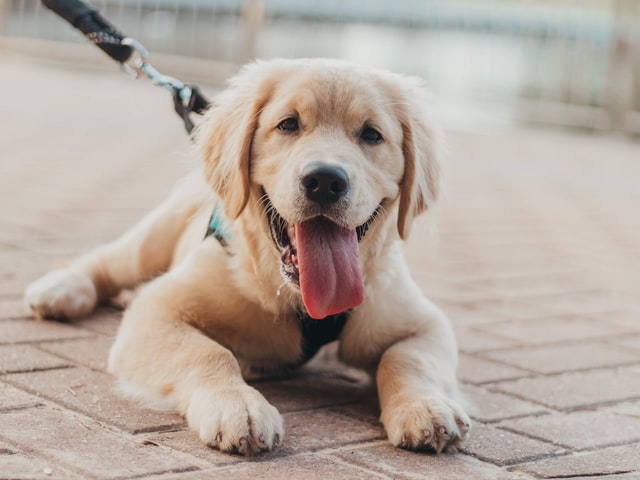
Why do puppies chew so much?
Puppies are a lot of work, but they’re worth the hassle! Puppies explore their world by putting things in their mouths. Since teething starts at about six months old for most puppies (though some might go through it as early as four months), chewing becomes a natural reaction to the process of teething. A puppy’s need to chew is not only because they are teething or sore. It also helps them release energy and makes them feel good. It’s normal and healthy for a puppy to want to chew. It’s what the puppy chews that can be a problem!
If left to his own devices, a puppy will chew on anything and everything, from your favorite shoes to expensive furniture. This situation can become dangerous if your pup chews the wrong things, like cords or cables. It’s important to teach your puppy which behaviors are acceptable because he won’t outgrow these habits without consistent and clear communication and guidance from his pup parent.
You will need to teach your pup what is not okay to chew, so he grows into a well-behaved adult dog. Here are some top tips to help you teach your puppy to stop chewing everything.
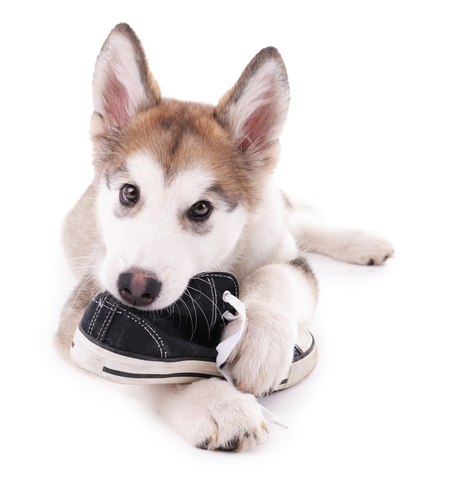
Top Tips to Teach Your Puppy to Stop Chewing
Puppy proof your home
Puppies often chew household items when those objects are left within the puppy’s reach. Minimizing chewing problems is easy with a little bit of planning. Take some time to ensure that:
- the trash out of reach
- items that need protection are not accessible to the pup
- place shoes and socks in a closet away from the puppy
- Make sure no remote controls are lying around the couch or floor; put them in a drawer or on the television.
Pup parents can limit the possibilities of damage by taking a few minutes every day to place items of importance in areas the puppy cannot access.
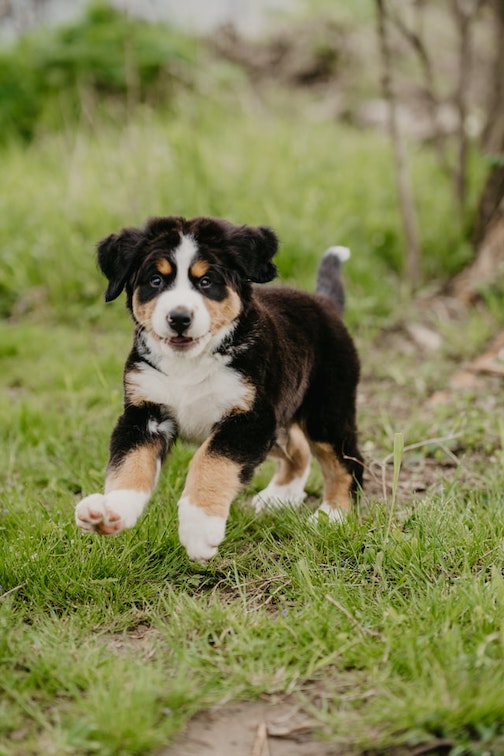
Pay attention to your pup.
Just as with children, supervision of a puppy is a vital factor in stopping inappropriate behavior before it starts. Watch your puppy when he’s roaming about. The puppy doesn’t know the house rules yet, so you have to show him what is acceptable and off-limits. Without supervision and direction, the puppy will act instinctively and chew whatever he can get her paws on.
To avoid any dangers, it is important always to supervise your puppy if he walks into the bathroom. Not only are there hazardous items that could harm your pup, but also objects such as rolls of toilet paper that you do not want him to grab. Also, keep all valuables, such as watches and jewelry, far away from little puppy mouths that may chew and swallow them.
Sometimes puppies chew things up because they are bored and want your attention. Make sure you give your pup plenty of time and love, so he will want to be with you more than chewing objects around the house. And always remember, your puppy needs gentle guidance. They are not trying to frustrate you with their puppy behavior. Always be kind and patient with your puppy. They want to please you, they just have trouble managing themselves at this young age.
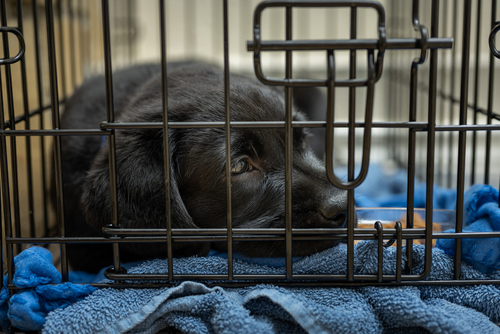
Confine your pup when necessary
If you have to leave your puppy alone, it is best if he stays confined to a crate or specific puppy-proofed area of the home. Puppies and young dogs often get bored and anxious when they are left alone, and chewing becomes a method to exercise that energy.
There are many benefits to crate training your puppy. Still, there is also an understanding that they have limited hours before they need a potty break. The general rule is a puppy can hold his bladder for one hour for every month of age. For example, a three-month-old pup can stay crated for about 3 hours while a six-month-old will manage 6 to 7 hours before he needs to go outside to eliminate.
The area where you confine your puppy must be free of any objects that he can chew. The only exception is age-appropriate toys, which are designed to avoid injuring your pup. Read on for more information about those toys!

Provide appropriate chew toys
To prevent puppy boredom, you may want to leave some safe chew toys for your pup in her crate or gated area of the home. These toys must be approved for puppy use. Unfortunately, many dog chew toys — especially stuffed animals — are not made with dogs’ safety in mind. They may have small parts that can fall off or be chewed up and become choking hazards to your pup. That’s just one reason why pup parents should give their little dogs safe toys specifically made for puppies.
Nylabone toys are great because they provide the perfect balance of durability and safety, and they won’t damage your puppy’s new teeth. Toys that are durable enough to chew or toys without stuffing are other options to consider for your little one.
Leave your scent for your pup.
If you are leaving your puppy for a more extended period, roll his favorite toy between the palms of both your hands before giving it to him. This action will transfer some of your scent to the toy and make your puppy more content while waiting for you to return home. Separation anxiety is often the cause of destructive dog chewing. Try leaving something that reminds your pup of you and makes him feel like you’re there with him. Your scent will keep him calm and happy.

Exercise your puppy daily
Engaging in age-and breed-appropriate exercise every day helps keep your puppy’s boredom at bay. It also relieves some of his high energy levels. A tired dog won’t engage in destructive chewing behavior like puppies often do when bored or feeling extra energetic. Establish a routine so your puppy can look forward to exercising every day, whether it’s a walk around the block or a romp in the backyard. Remember, a tired puppy is a happy puppy!
Interrupt, then replace
If you notice your dog is chewing something she shouldn’t, immediately replace that item with a chew toy. Don’t punish or raise your voice at him, as that will only make the puppy fearful of you and damage your bond with him.
Suppose the new toy isn’t appealing to your puppy after all. Pups are babies with short attention spans, so try buying different toys. Fill a Kong toy with water or peanut butter, then frozen, and then given to your puppy as a tempting treat. The cold will feel especially good on your puppy’s teeth and gums.
Positive reinforcement is key to teaching your puppy what not to chew. By quickly replacing the item you don’t want him to chew with an enticing toy, you teach him what is and is not acceptable to chew.
Try taste repellents
Taste repellents, also called chewing repellents, are another way to stop your puppy from destructive chewing. Apply this spray to shoes, furniture, table legs, or any other item your puppy gravitates toward when he wants to chew. Commercial taste repellents are usually bitter apple flavored. Still, you can make DIY deterrent sprays with apple cider vinegar or lemon juice. These strong tastes and smells will encourage your puppy to steer clear of any item you’ve sprayed.
NOTE: You can’t spray items once and think that that will do the trick. You’ll need to reapply the spray every day for two to four weeks until your pup learns to stay away.
Don’t confuse your pup
Never give your puppy old shoes, socks, hats, gloves or anything else along these lines to chew on. You may not think it’s a bid deal now because you don’t care if these old items are destroyed. But what happens in the future when you come home and realize that your dog has shoed apart your brand new sneakers. Well, you’re probably going to be mad and yell. but this isn’t very fair to your dog as you gave them shoes to chew on. Don’t confuse your fur baby. Make it clear what is and isn’t okay for them to chew on from the very beginning.
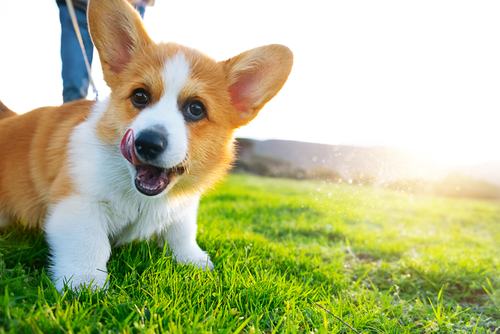
Keep calm and puppy on!
It’s natural for puppies to chew. Being a patient and consistent pup parent is necessary to establish rules for your dog that will keep him safe as he grows into doghood. With positive reinforcement and loving care, you and your puppy will soon be on the same page when it comes to chewing.
Did you know the best time to purchase a pet insurance policy is when your puppy is young? Your monthly payments are affordable. Additionally, you will reap the full benefits of policy coverage by insuring your puppy before he develops any pre-existing conditions. Let Pet Insurance Review find the best dog insurance quotes for your pup and your budget. Get your puppy a free quote today!
References:
1. Donovan, L. (2019). Puppy Teething Timeline. Retrieved from https://www.akc.org/expert-advice/health/timeline-of-puppy-teething/
2. Gerrity, S. (2020). The Do’s and Don’ts of Crate Training a Puppy. Retrieved from https://www.dailypaws.com/dogs-puppies/training/basic/crate-training-a-puppy
3. Instinct Dog Behavior and Training. How to Potty Train Your Puppy. Retrieved from https://www.instinctdogtraining.com/how-to-potty-train-your-puppy/
4. Naish, D. (2016). 3 Types of Most Unsafe Dog Toys for Puppies. Retrieved from https://topdogtips.com/most-unsafe-dog-toys-for-puppies/
4. Sargisson, R. (2014). Canine separation anxiety: strategies for treatment and management. Retrieved from https://www.dovepress.com/canine-separation-anxiety-strategies-for-treatment-and-management-peer-reviewed-fulltext-article-VMRR
5. Stordahl, L. (2015). 5 Puppy Exercise Tips: How to Get Your Puppy Tired. Retrieved from https://blog.dogids.com/5-puppy-exercise-tips-how-to-get-your-puppy-tired/
DisclaimerThe information contained on this blog is intended for informational and educational purposes only and should not be construed as medical advice. It is not a substitute for professional veterinary care. Always consult with your veterinarian before making any changes to your pet's health care or treatment plan.
The authors of this blog are not veterinarians and do not claim to be experts in pet health. The information provided here is based on our own experiences and research, as well as information from reputable sources. However, we cannot guarantee the accuracy or completeness of this information.
We encourage you to do your own research and consult with your veterinarian before making any decisions about your pet's health.
Previous post
How to Treat Your Dogs Arthritis in WinterNext post
Dog Training Tips For New Pup ParentsCompare top pet insurance providers plans.
Enter your dog’s age in years and months to calculate their age equivalent to human years.
Calculate your dog’s ageEnter your cat’s age in years and months to calculate their age equivalent to human years.
Calculate your cat’s age